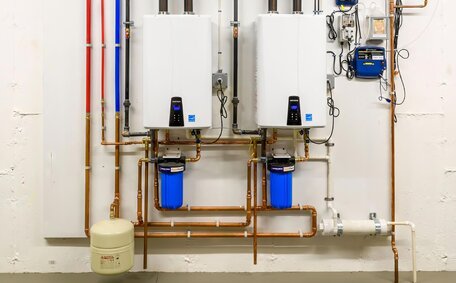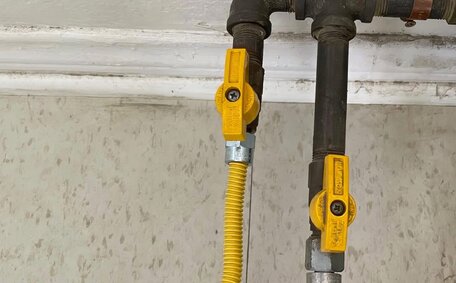
How Hard Water Hurts Hot Water Heaters
Hard water leaves mineral deposits in heaters, pipes and tanks. This limescale reduces efficiency, lifespan and hot water availability. Contact us for affordable water softening solutions.
Read MoreThe oil and gas industry is fraught with significant risks, necessitating strict health and safety precautions.
Workers are exposed to toxic fumes, fire hazards, and the threat of explosions, with arc flash fires capable of exceeding 1000 degrees Celsius within moments.
Personal Protective Equipment (PPE) is essential for safeguarding workers in these perilous conditions. For your workers, training, fit testing, and proper application of PPE safety gear is vital for workplace health safety.
Gloves, safety boots and comprehensive full body safety equipment guard against burns and impacts. By employing comprehensive PPE, we mitigate the risks associated with gas work, reducing the likelihood of accidents.
Donning a hard hat is crucial for maintaining a safe working environment in oil and gas operations. Hard hats and safety helmets are PPE oil gas industry workers require to shield head face eye areas from impact injuries caused by falling objects, debris, tools, and other hazards. They also safeguard the head, neck, and face against the potentially devastating impact of an explosion.
Various types of industrial hard hats should be considered for different PPE needs:
All hard hats, as protective equipment PPE required, must meet industry workers safety standards like ANSI Z89.1 and AS/NZS 1801. Safety attire, including safety shoes, must be worn at all times during gas line work where falling objects pose a risk and equipment is in use.
Daily inspections for cracks or damages are crucial to ensure PPE remains effective. Replace immediately if compromised.
Additionally, fire-resistant balaclavas and other garments offer protection for the neck, face, and head from flash fires reaching up to 1000°C. Hard hats maintain structural integrity if impacted at high speed during a gas explosion.
Using appropriate head protection equipment, including PPE that meets oil industry standards, helps prevent severe or fatal head injuries. Safety managers must provide proper head protection and enforce continual use on all gas job sites.
Safeguarding the eyes and face is crucial when using high-pressure equipment in gas operations. Various hazards like chemical splashes, flying debris, intense UV light from flame cutting, and more can damage eyesight. Goggles face protection, and face shields offer head, face, and eye protection against a multitude of hazards.
Australian standards (AS/NZS 1336 and AS/NZS 1337) classify eye and face protectors into several categories based on the impact protection they provide. Common types include:
Tinted safety glasses with side shields aid against glare, while wire-mesh versions offer protection from sharp flying particles. Prescription safety eyewear allows glasses-wearers proper vision while working.
All eye and face safety products must also be certified from a wide variety of standards to ensure they protect your eyesight. Daily checks before use are vital in keeping safety gear in prime condition, avoiding scratches, fogging, and damage to ensure uncompromised protection. Correct practices to prevent coming into contact with eyes, such as avoiding rubbing, should be followed.
By adopting high-quality eye and face protection against numerous hazards, we help workers in the oil and gas industries prevent vision damage and lost time, thereby enhancing safety and productivity.
Respiratory protection is imperative for individuals involved in gas extraction, where hazardous gases are a concern. Toxic fumes, such as hydrogen sulphide, can be fatal within seconds, thus no exposure should be dismissed lightly. Respirators and breathing apparatus are necessary to provide clean air and safeguard against threats such as molten metal in the industry.
The following are the various types of respiratory PPE:
All respirators must undergo fit testing with comprehensive PPE training, meeting PPE requirements, and considering safety data specific to the individual and face type. Essential to high-risk environments is proper training on the use and maintenance of respirator equipment. Facial hair can prevent a tight seal so must be removed.
Regular checks of filters, seal integrity, proper cleaning, disinfecting, and correct storage of equipment are essential for maximum protection in the oil and gas sector. Daily inspections provide adequate checks for tears or valve issues.
By mandating certified respirators, ensuring proper fit and training in use, workers avoid respiratory disease and remain vigilant against dangerous gas exposures.
Protection against intense heat from possible flash fires or gas ignitions is crucial for body safety. Flame resistant (FR) clothing provides a crucial shield against burns over large surface areas of the body.
FR garments, to be worn whenever there’s a risk of exposure, are made from materials such as treated cotton and carbon fibre, which self-extinguish upon brief fire contact. This product line includes flame-resistant lab coats, safety coveralls, pants, jackets, and high-visibility uniforms.
All body protection PPE must conform to standards such as NFPA 2112. Garments should fit comfortably without impeding movement. FR clothing requires proper care like laundering only with similar items to retain fire resistance.
FR clothing, fire proof spats, metatarsal boots and fire retardant gloves add protection for hands and feet during gas line work.
Utilising protective FR workwear enables workers to protect themselves from severe, potentially fatal or debilitating, deep tissue burns in flash fire accidents.
When handling pressurised gas lines, appropriate hand protection is essential. Various hazards like toxic fumes, flammable gases, extreme heat and cold, sharp edges and abrasions can damage hands. High quality protective gloves can protect hands and prevent injuries.
There are different types of protective gloves:
Workers should make sure that all protective gloves, worn all day, comply with standards like EN388, EN407 and AS/NZS 2161. They should fit properly without limiting dexterity. Rips, tears or holes mean gloves should be replaced immediately to ensure continued protection.
Proper use and maintenance like regular inspection, cleaning and storage ensures gloves remain protective. Mandating certified hand PPE, training workers in proper wear and replacement regimes prevents hand and finger injuries.
Through quality protective gloves, safe work is ensured as gas technicians retain hand and finger function, protecting their ability to conduct complex technical procedures during gas operations.
In gas line operations, protecting feet from crush injuries is essential. Safety boots also offer slip resistance, ankle support, and protection from electrical hazards.
Heavy pipes, tools and equipment can cause harm. Quality steel-toed industrial safety products prevent toe impact and compression damage.
There are different types of safety boots:
All protective boots must meet standards like AS/NZS 2210.3. They should fit comfortably with good traction to prevent slips and falls. Inspections check for cracks, holes and separation.
Proper use like pairing with metatarsal guards during welding protects feet from sharp metals and heat. To make sure soles are oil resistant, regular checks are needed to maintain grip. Periodic cleaning and conditioning preserves leather.
By wearing certified steel-toed boots, workers can take steps utilising metatarsals during welding, and training workers to check their foot protection, gas technicians avoid broken bones and burns - remaining injury free on the job.
Hearing protection is crucial when working with noisy equipment in gas operations. Prolonged noise exposure from equipment like pneumatic pumps, generators and power tools can cause permanent hearing damage over time. Quality hearing protection like earmuffs and earplugs are essential for world health standards.
Foam or custom-moulded earplugs can worn directly into ear canals for a snug seal.
They can be worn when into the most common varieties, corded or uncorded, and in different sizes. Earmuffs fully enclose the ear to block sound waves. Earmuffs fully enclose the ear to block sound waves.
All hearing PPE worn over the ears must comply with AS/NZS 1270 Acoustics standards. They should be comfortable and fit correctly to avoid shifting or dislodging. Regular inspection can also checks for cracking or rigidity from oil exposure.
Proper use like pairing muffs and plugs provides protection across noise frequencies. Training workers on fitting techniques improves effectiveness. Rotating workers from high noise areas reduces exposure.
By mandating hearing PPE and its continuous proper wear, those who work with gas can avoid permanent hearing loss and related health declines - safeguarding long-term auditory health.
Proper understanding of PPE usage is vital to ensure optimal safety and adequate protection. It is essential for workers to be proficient in PPE protocols, such as inspection, donning, removal, and storage.
Regular inspections should used to check for damage, wear and integrity issues. Cracks, holes, tears or malfunctions mean equipment should be taken out of use. Daily risk assessment processes can help identify potential hazards and are crucial in the evaluation of ppe such as helmets and gloves.
Putting on and taking off PPE must follow strict sequences, without any shortcuts, to prevent contamination, particularly when handling flammable liquids. All straps, zips and fittings should be secure and comfortable without impairing safe working practices or movement.
Cleaning procedures like disinfecting, repairs and replacement regimes maintain protective function. Proper Storage ensures where PPE is worn at all times and maintained in a clean, dry state, ready for your workplace.
Employers must implement control measures such as providing cleaning stations, replacing used PPE, and mandating training to uphold workplace health and safety. Your employees must adhere to all procedures and request new PPE when necessary, being ready for any emergency response.
By instilling strict PPE protocols through validation schemes, continual training and proper maintenance regimes, employers ensure equipment protects properly during rigorous gas operations.
Hard water leaves mineral deposits in heaters, pipes and tanks. This limescale reduces efficiency, lifespan and hot water availability. Contact us for affordable water softening solutions.
Read MoreIt’s important to routinely check your gas appliances for any issues. Signs of problems include gas leaks, strange sounds, odd smells and more. Have a professional inspect your gas appliances annually and service them regularly for safety.
Read MoreUpgrading your gas meter is a simple process completed by registered technicians. It involves disconnecting your gas supply for 15 minutes to swap the old meter for a new digital smart meter. The upgrade is free and improves accuracy.
Read MorePicnic Point, 2213 NSW
We will call back as soon as possible.




